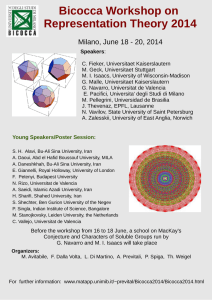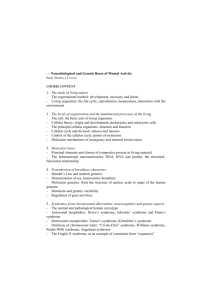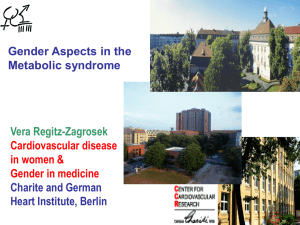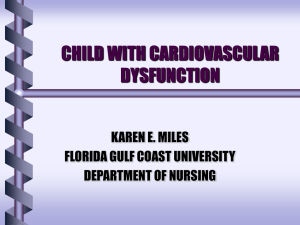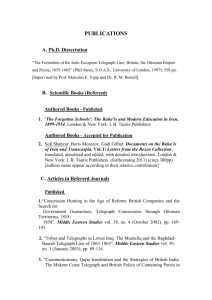PDF, 155.72 KB - Journal of Cardiovascular Disease Research
advertisement
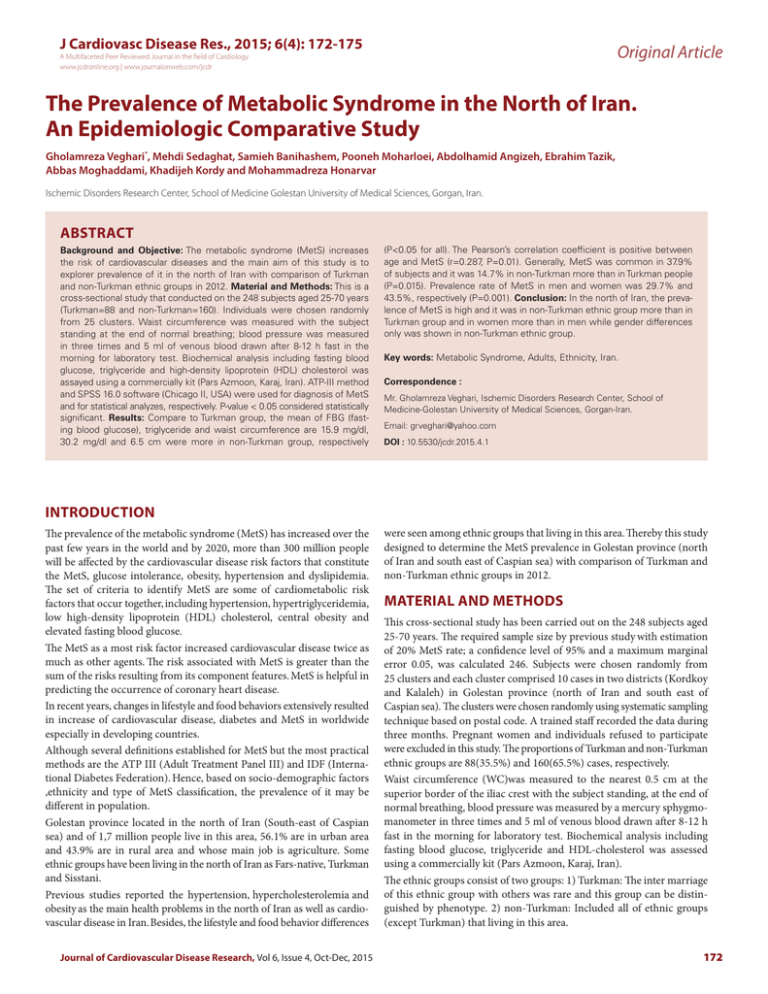
J Cardiovasc Disease Res., 2015; 6(4): 172-175 Original Article A Multifaceted Peer Reviewed Journal in the field of Cardiology www.jcdronline.org | www.journalonweb.com/jcdr The Prevalence of Metabolic Syndrome in the North of Iran. An Epidemiologic Comparative Study Gholamreza Veghari*, Mehdi Sedaghat, Samieh Banihashem, Pooneh Moharloei, Abdolhamid Angizeh, Ebrahim Tazik, Abbas Moghaddami, Khadijeh Kordy and Mohammadreza Honarvar Ischemic Disorders Research Center, School of Medicine Golestan University of Medical Sciences, Gorgan, Iran. ABSTRACT Background and Objective: The metabolic syndrome (MetS) increases the risk of cardiovascular diseases and the main aim of this study is to explorer prevalence of it in the north of Iran with comparison of Turkman and non-Turkman ethnic groups in 2012. Material and Methods: This is a cross-sectional study that conducted on the 248 subjects aged 25-70 years (Turkman=88 and non-Turkman=160). Individuals were chosen randomly from 25 clusters. Waist circumference was measured with the subject standing at the end of normal breathing; blood pressure was measured in three times and 5 ml of venous blood drawn after 8-12 h fast in the morning for laboratory test. Biochemical analysis including fasting blood glucose, triglyceride and high-density lipoprotein (HDL) cholesterol was assayed using a commercially kit (Pars Azmoon, Karaj, Iran). ATP-III method and SPSS 16.0 software (Chicago II, USA) were used for diagnosis of MetS and for statistical analyzes, respectively. P-value < 0.05 considered statistically significant. Results: Compare to Turkman group, the mean of FBG (fasting blood glucose), triglyceride and waist circumference are 15.9 mg/dl, 30.2 mg/dl and 6.5 cm were more in non-Turkman group, respectively (P<0.05 for all). The Pearson’s correlation coefficient is positive between age and MetS (r=0.287, P=0.01). Generally, MetS was common in 37.9% of subjects and it was 14.7% in non-Turkman more than in Turkman people (P=0.015). Prevalence rate of MetS in men and women was 29.7% and 43.5%, respectively (P=0.001). Conclusion: In the north of Iran, the prevalence of MetS is high and it was in non-Turkman ethnic group more than in Turkman group and in women more than in men while gender differences only was shown in non-Turkman ethnic group. Key words: Metabolic Syndrome, Adults, Ethnicity, Iran. Correspondence : Mr. Gholamreza Veghari, Ischemic Disorders Research Center, School of Medicine-Golestan University of Medical Sciences, Gorgan-Iran. Email: grveghari@yahoo.com DOI : 10.5530/jcdr.2015.4.1 INTRODUCTION The prevalence of the metabolic syndrome (MetS) has increased over the past few years in the world and by 2020, more than 300 million people will be affected by the cardiovascular disease risk factors that constitute the MetS, glucose intolerance, obesity, hypertension and dyslipidemia. The set of criteria to identify MetS are some of cardiometabolic risk factors that occur together, including hypertension, hypertriglyceridemia, low high-density lipoprotein (HDL) cholesterol, central obesity and elevated fasting blood glucose. The MetS as a most risk factor increased cardiovascular disease twice as much as other agents. The risk associated with MetS is greater than the sum of the risks resulting from its component features. MetS is helpful in predicting the occurrence of coronary heart disease. In recent years, changes in lifestyle and food behaviors extensively resulted in increase of cardiovascular disease, diabetes and MetS in worldwide especially in developing countries. Although several definitions established for MetS but the most practical methods are the ATP III (Adult Treatment Panel III) and IDF (International Diabetes Federation). Hence, based on socio-demographic factors ,ethnicity and type of MetS classification, the prevalence of it may be different in population. Golestan province located in the north of Iran (South-east of Caspian sea) and of 1,7 million people live in this area, 56.1% are in urban area and 43.9% are in rural area and whose main job is agriculture. Some ethnic groups have been living in the north of Iran as Fars-native, Turkman and Sisstani. Previous studies reported the hypertension, hypercholesterolemia and obesity as the main health problems in the north of Iran as well as cardiovascular disease in Iran. Besides, the lifestyle and food behavior differences Journal of Cardiovascular Disease Research, Vol 6, Issue 4, Oct-Dec, 2015 were seen among ethnic groups that living in this area. Thereby this study designed to determine the MetS prevalence in Golestan province (north of Iran and south east of Caspian sea) with comparison of Turkman and non-Turkman ethnic groups in 2012. MATERIAL AND METHODS This cross-sectional study has been carried out on the 248 subjects aged 25-70 years. The required sample size by previous study with estimation of 20% MetS rate; a confidence level of 95% and a maximum marginal error 0.05, was calculated 246. Subjects were chosen randomly from 25 clusters and each cluster comprised 10 cases in two districts (Kordkoy and Kalaleh) in Golestan province (north of Iran and south east of Caspian sea). The clusters were chosen randomly using systematic sampling technique based on postal code. A trained staff recorded the data during three months. Pregnant women and individuals refused to participate were excluded in this study. The proportions of Turkman and non-Turkman ethnic groups are 88(35.5%) and 160(65.5%) cases, respectively. Waist circumference (WC)was measured to the nearest 0.5 cm at the superior border of the iliac crest with the subject standing, at the end of normal breathing, blood pressure was measured by a mercury sphygmomanometer in three times and 5 ml of venous blood drawn after 8-12 h fast in the morning for laboratory test. Biochemical analysis including fasting blood glucose, triglyceride and HDL-cholesterol was assessed using a commercially kit (Pars Azmoon, Karaj, Iran). The ethnic groups consist of two groups: 1) Turkman: The inter marriage of this ethnic group with others was rare and this group can be distinguished by phenotype. 2) non-Turkman: Included all of ethnic groups (except Turkman) that living in this area. 172 Gholamreza Veghari et al.: The Prevalence of Metabolic Syndrome in the North of Iran ATP-III method was used for diagnosis of MetS. According to this criteria, the presence of at least three of five the following criteria were included as MetS: (1) Abdominal obesity as measured by WC > 102 cm in men and >88 cm in women; (2) Triglycerides >150 mg/dl; (3) HDL cholesterol <40 mg/dl in men and <50 mg/dl in women; (4) SBP-systolic blood pressure ≥130 or DBP-diastolic blood pressure ≥85 mm/Hg; (5) fasting plasma glucose ≥110 mg/dl. 16.0 software (Chicago II, USA) was used for the statistical analysis using chi-square test and t.test for comparing frequencies and the means, respectively. P-value < 0.05 considered statistically significant. This study was approved by Ethical Research Committee and consent was received from all participants. RESULTS Mean and standard deviation of MetS components and age based on ethnicity and gender were presented in Table 1. Compare to Turkman group, the means of FBG (fasting blood glucose), triglyceride and waist circumference are 15.9 mg/dl, 30.2 mg/dl and 6.5 cm higher in nonTurkman group, respectively (P<0.05 for all) while the mean of HDLc in Turkman group was significantly 4.9 mg/dl higher than in non-Turkman group (P=0.006). HDLc level in women was higher than in men in two ethnic groups (P<0.05). The Pearson correlation was shown a positive association between age and MetS (r=0.287, P=0.01). The prevalence of MetS and its components according to ethnicity were presented in Table 2. Generally, the MetS was common in 37.9% of subjects and it was significantly 14.7% more in non-Turkman than in Turkman groups (P=0.015). Prevalence rate of MetS in men and women was 29.7% and 43.5% respectively (P=0.001). MetS prevalence differences was not significant between genders in Turkman group but it was significantly more in women than in men in non-Turkman group (31.3% vs 51.6%) (P=0.008). The prevalence differences of diabetes mellitus, hypertension, hypertriglyceridemia, low HDLc and central obesity were significant between two ethnic groups. (P<0.05 for all). DISCUSSION The exact mechanisms of the MetS are under investigation. Its pathophysiology is very complex and has been only partially explicated. Sympathetic nervous system overactivity is a key mechanism leading to hypertension and increasing obesity has led to a marked increase in MetS risk factors. Insulin resistance is strongly associated with excess triglyceride stores in multiple tissues. Based on epidemiologic studies on MetS, a variety o prevalence rate has been observed in Iran. The finding of our study has been indicated the high prevalence of MetS at 37.9% as whole in the north of Iran, so it was more in non-Turkman group (43.1%) more than in Turkman group (28.4%) and in women more than in men. In a population based study on 3024 Iranian adults aged 25 – 64 years from 30 provinces, the age-adjusted prevalence of MetS was about 34.7% and in another study, the prevalence of MetS was seen in 33.2% of adults in Tehran, according to the ATP III definition. In other parts of Iran, MetS was common 23% in Zanjan , 21% (15.4% in men and 24.9% in women) in Zahedan and 28.5% (17% in men and 37.8% in women) in Semnan. Similarly, studies in worldwide, revealed a great variety in the prevalence of MetS ranging from 4% in a rural area in Japan to 63.7% in an urban area in Pakistan. The prevalence of MetS according to the ATP III in Irish population was 13.2%, in urban Pkistan was 49% in adult Qatari was 33.7% , in Korean adults was 15-30%, in Thailand was 16.6% (18.5% in men and 14.7% in women), in Indian American in northern California was 33.9% and in Chinese adult population was 24.2% ( 22.1% in men and 25.8% in women). The prevalence rate of MetS is associated with some of socio-demographic factors, lifestyle and food behaviors and it was different in worldwide. The MetS clearly prevalent more in our area compared with some regions in Iran and in other countries although the amount was less than other parts. The MetS prevalence rate in our area study is in alarming rate and a controlling program for it should be established. Table 1: Baseline quantitative characteristics of the participants, Mean (standard deviation) Age year FBG mg/dl SBP mm/hg DBP mm/hg TG mg/dl HDLc mg/dl WC cm Men(34) Women(54) Total(88) P-Value* 45.6(12.8) 43.1(13.8) 44.0(13.4) 0.854 91.1(15.5) 86.7(13.2) 88.4(14.2) 0.153 126.7(15.7) 124.0(20.5) 125.0(18.8) 0.521 79.2(8.9) 80.1(14.2) 79.8(12.4) 0.751 126.8(72.7) 126.7(79.4) 126.7(76.5) 0.995 49.8(11.9) 56.9(13.9) 54.1(13.5) 0.015 89.5(16.1) 92.1(14.7) 91.1(15.2) 0.439 Men(67) Women(93) Total(160) P-Value* 47.3(14.3) 47.7(13.6) 47.6(13.8) 0.861 107.6(50.4) 101.9(39.4) 104.3(44.3) 0.435 127.1(18.3) 131.3(26.5) 129.5(23.3) 0.265 82.2(11.1) 84.2(13.5) 83.4(12.5) 0.332 158.3(103.5) 156.0(99.8) 156.9(101.1) 0.889 45.2(11.7) 52.0(14.3) 49.2(13.7) 0.002 97.9(12.9) 97.3(14.6) 97.6(13.9) 0.789 Men(101) Women(147) P-Value** 46.7(13.8) 46.0(13.8) 0.681 46.3(13.8) 0.052 102.1(42.7) 96.3(33.1) 0.229 98.6(37.3) 0.001 81.2(10.5) 82.7(13.9) 0.386 127.9(21.9) 0.130 126.9(17.4) 128.6(24.6) 0.527 82.1(12.6) 0.032 147.7(95.0) 145.3(93.7) 0.841 146.2(94.1) 0.015 46.7(11.9) 53.8(14.3) 0.001 50.9(13.8) 0.006 95.1(14.6) 95.4(14.8) 0.868 95.3(14.7) 0.001 Characteristics Turkman NonTurkman Gender Whole(248) P-Value*** * for differences between genders in each of ethnic groups/** for differences between genders as whole; *** for differences between two ethnic groups. FBG-fasting blood glucose, SBP-systolic blood pressure, DBP-diastolic blood pressure, TG-triglycerides, HDLc- high-density lipoprotein cholesterol, WC- waist circumference. Journal of Cardiovascular Disease Research, Vol 6, Issue 4, Oct-Dec, 2015 173 Gholamreza Veghari et al.: The Prevalence of Metabolic Syndrome in the North of Iran Table 2: Prevalence of MetS and components contributed to it based on ethnicity and gender N (%) FBG N(%) Hypertension N(%) TG N(%) HDLc N(%) Abdominal Obesity N(%) MetS N(%) Men(34) Women(54) Total(88) P-Value * 3(8.8) 6(11.1) 9(102.2) 0.516 28(82.4) 31(57.4) 59(67.0) 0.013 12(35.2) 14(25.9) 26(29.5) 0.242 7(20.6) 16(29.6) 23(26.1) 0.247 6(17.6) 28(51.9) 34(38.6) 0.001 9(26.5) 16(29.6) 25(28.4) 0.473 Men(67) Women(93) Total(160) P-Value* 14(20.9) 32(34.4) 46(28.8) 0.045 34(50.7) 49(52.7) 83(51.9) 0.467 30(44.8) 45(48.4) 75(46.9) 0.386 25(37.3) 44(47.3) 69(43.1) 0.136 23(34.3) 69(74.2) 92(57.2) 0.001 21(31.3) 48(51.6) 69(43.1) 0.008 Men(101) Women(147) P-Value** 17(16.8) 38(25.9) 0.093 55(22.2) 0.001 62(61.4) 80(54.4) 0.276 142(53.7) 0.014 42(41.6) 59(40.1) 0.819 101(40.7) 0.005 32(31.7) 60(40.8) 0.001 92(37.1) 0.006 29(28.7) 97(66.0) 0.001 126(50.8) 0.003 30(29.7) 64(43.5) 0.027 94(37.9) 0.015 Characteristics Turkman Non-Turkman Gender Whole(248) P-Value*** *for differences between genders in each of ethnic groups/** for differences between genders as whole/*** for differences between two ethnic groups. FBG-fasting blood glucose, TG-triglycerides, HDLc-high-density lipoprotein cholesterol, MetS-metabolic syndrome. In present study, we found the prevalence of MetS in non-Turkman group more than in Turkman group. There are some reports that agree with the impact of ethnicity on MetS components. Africans people have higher HDLc level compared with Caucasians people. In a epidemiologic study in rural area in China was found the ethnicity and female gender as a cardiometabolic risk factor. The prevalence of obesity and MetS depends on ethnicity and gender was common more in the Russians than in the Chuvashes population. In the eastern part of Slovakia, the MetS components prevalence were different between Roma and non-Roma subjects. Previous studies in the north of Iran reported the obesity in Turkman ethnic group less than in Fars-native subjects. The lifestyle and food behaviors between Turkman people and other ethnic groups are not alike. These differences may be resulted in cardiovascular risk factors varieties among them. Establishing a comprehensive study is necessary to determine the MetS substantial factors among ethnic groups in the north of Iran. In line with previous studies in the literature, MetS was more exhibited in women than in men in our area study. Despite, significant MetS gender difference was seen in nonTurkman group, it was not considerable in Turkman group. The gender prevalence differences partly explained by females’ sedentary life style compared to males, considering the cultural context in the north of Iran. On the other hand, men mostly work in outdoor while women work at home. There is necessary to establish a comprehensive study to explorer wherefore MetS was not different in gender in Turkman ethnic group. In summary, alarming rate of MetS was seen among northern adults in Iran and it was in non-Turkman ethnic group more than in Turkman group and in women more than in men. Gender differences were seen only in non-Turkman ethnic group. We didn’t evaluate food behavior, physical activities, food intake and lifestyle. In addition, the sample size was low and we did not provide a proper statistical test to consider the design effect caused by cluster sampling. They are our limiting study. ACKNOWLEDGEMENT The authors would like to thank the medical and administrative staff in the Primary Health Care Centers for their valuable assistance during the field work. This study based on 239670 official documents was justified for publication and created from provincial non-communicable data study. This study financially has been supported by Health Office of Golestan University of Medical Sciences. REFERENCES 1. Mokdad AH, Ford ES, Bowman BA, et al. Prevalence of obesity, diabetes, and obesity-related health risk factors, 2001. JAMA. 2003; 289: 76-79. 2. Reaven G. The insulin resistance syndrome: definition and dietary approaches to treatment. Annu Rev Nutr. 2005; 25:391-406. 3. Steinberger J, Daniels SR, Eckel RH, Hayman L, Lustig RH, McCrindle B, et al. Progress and Challenges in Metabolic Syndrome in Children and Adolescents A Scientific Statement From the American Heart Association Atherosclerosis, Hypertension, and Obesity in the Young Committee of the Council on Cardiovascular Disease in the Young; Council on Cardiovascular Nursing; and Council on Nutrition, Physical Activity, and Metabolism. Circulation 2009; 119(4): 628-47. 4. Grundy SM, Cleeman JI, Daniels SR, Donato KA, Eckel RH, Franklin BA, et al. Diagnosis and management of the metabolic syndrome: an American heart association/national heart, lung, and blood institute scientific statement. Circulation 2005; 112: 2735-52. 5. Lakka HM, Laaksonen DE, Lakka TA, Niskanen LK, Kumpusalo E, Tuomilehto J, et al. The metabolic syndrome and total cardiovascular disease mortality in middle-aged men. JAMA. 2002; 288(21): 2709-16. 6. Sattar N, Gaw A, Scherbakova O, Ford I, O’Reilly DS, Haffner SM, et al. Metabolic syndrome with and without C-reactive protein as a predictor of coronary 174 heart disease and diabetes in the West of Scotland Coronary Prevention Study. Circulation. 2003; 108(4): 414-9. 7. Kahn R, Buse J, Ferrannini E, Stern M. The metabolic syndrome: time for a critical appraisal: joint statement from the American Diabetes Association and the European Association for the Study of Diabetes. Diabetes Care. 2005; 28: 2289-304. 8. Fakhrzadeh H, Ghotbi S, Pour-Ebrahim R, Nouri M, Heshmat R, Shafaee A, et al. Evaluation of prevalence of the metabolic syndrome in inhabitants of Tehran university of medical sciences population lab. Iran J Diabetes Lipid Disord 2004; 3: 71-80. [Persian] 9. Wannamethee SG, Shaper AG, Lennon L, Morris RW. Metabolic syndrome vs Framingham Risk Score for prediction of coronary heart disease, stroke, and type 2 diabetes mellitus. Arch Intern Med. 2005; 165: 2644-50. 10. Alwan A. Global status report on noncommunicable diseases. 2010; WHO, 2011. 11. Alberti KG, Zimmet P, Shaw J. IDF Epidemiology Task Force Consensus Group. The metabolic syndrome: a new worldwide definition from the international diabetes federation consensus. Lancet 2005; 366: 1059-1062. 12. Statistical Center of Iran. Population and Housing Census [Online]. 2012; Available from: URL: http://www.amar.org.ir/Portals/1/Iran/census-2.pdf Journal of Cardiovascular Disease Research, Vol 6, Issue 4, Oct-Dec, 2015 Gholamreza Veghari et al.: The Prevalence of Metabolic Syndrome in the North of Iran 13. Veghari G, Sedaghat M, Banihashem S, Moharloei P, Angizeh A,Tazik E, et al. Impact of literacy on the prevalence, awareness treatment and control of hypertension in adults in Golestan Province (northern Iran). Caspian J Intern Med. 2013; 4(1): 580-4. 14. Veghari G, Sedaghat M, Joshghani H, Banihashem S, Moharloei P, Angizeh A, et al. Obesity and risk of hypercholesterolemia in Iranian northern adults. ARYA Atheroscler. 2013;9(1):2-6. 15. Veghari G, Sedaghat M, Banihashem S, Moharloei P, Angizeh A, Tazik E, et al. Trends in Waist Circumference and Central Obesity in Adults, Northern Iran. Oman Medical Journal.2012; 27(1): 50-3. 16. Veghari G, Sedaghat M, Joshaghani H, Hoseini A, Niknezhad F, Angizeh A, et al. The Prevalence of Obesity and its Related Risk Factor in the North of Iran in 2006.Journal of Research in Health Sciences ( JRHS) 2010; 10(2): 116-21. 17. Veghari G, Sedaghat M, Maghsodlo S, Banihashem S, Moharloei P, et al. Differences in the Prevalence of Obesity among Fars-Native, Turkman, and Sisstanish Ethnic Groups in Iranian Northern Adults in 2010.Int Cardiovasc Res J. 2013; 7 (2): 56-61. 18. Veghari G, Sedaghat M, Joshaghani H, Hoseini A, Niknezhad F, Angizeh A, et al. The Prevalence and Associated Factors of Central obesity in Northern Iran. Iranian Cardiovascular Research Journal. 2010; 4(4): 164-8. 19. Malek M, Hadaegh F, Harati H, Azizi F. Prediction of cardiovascular disease by metabolic syndrome in individuals aged over 40 yrs according to the ATP III and IDF definition: Tehran lipid and glucose study. Iran J Med Educ 2006; 8: 249-57. [Persian] 20. Sharifi F, Mousavinasab SN, Saeini M, Dinmohammadi M. Prevalence of metabolic syndrome in an adult urban population of the west of Iran. Exp Diabetes Res. 2009; 2009:136501. 21. Expert Panel on Detection, Evaluation, and Treatment of High Blood Cholesterol in Adults. Executive Summary of The Third Report of The National Cholesterol Education Program (NCEP) Expert Panel on Detection, Evaluation, And Treatment of High Blood Cholesterol In Adults (Adult Treatment Panel III). JAMA. 2001; 285(19): 2486-97. 22. Canale MP, Manca di Villahermosa S, Martino G, Rovella V, Noce A,et al. Obesityrelated metabolic syndrome: mechanisms of sympathetic overactivity. Int J Endocrinol. 2013;2013:865965. 23. Wu Z, Soulages JL, Joshi BD, Daniel SM, Hager ZJ, Arrese EL. TGL-mediated lipolysis in Manduca sexta fat body: possible roles for lipoamide-dehydrogenase (LipDH) and high-density lipophorin (HDLp). Insect Biochem Mol Biol. 2014; 45: 58-68. 24. Zhang C, Klett EL, Coleman RA. Lipid signals and insulin resistance. Clin Lipidol. 2013; 8(6): 659-67. 25. Delaveri A, Forouzanfar MH,Alikani S, Sharifian A, Kalishadi R. First nationwide study of the prevalence of the metabolic syndrome and optimal cutoff points of waist circumference in the Middle East: The national survey of risk factors for noncommunicable diseases of Iran. Diabetes Care. 2009; 32(6): 1092–7. 26. Zabetian A, Hadaegh F, Azizi F. Prevalence of metabolic syndrome in Iranian adult population, concordance between the IDF with the ATP III and WHO definition. Diabetes Res Clin Pract. 2007; 77(2): 251-7. 27. Kaykhaei MA, Hashemi M, Narouie B, Shikhzadeh A, Jahantigh M, Shirzaei E, Journal of Cardiovascular Disease Research, Vol 6, Issue 4, Oct-Dec, 2015 et al. Prevalence of Metabolic Syndrome in Adult Population from Zahedan, Southeast Iran. Iran J Public Health. 2012; 41(2): 70-6. 28. Ghorbani R, Abtahi naeini B, Eskandarian R, Rashidy-Pour A, Ebrahim Khamseh M, et al. Prevalence of metabolic syndrome according to ATPIII and IDF criteria in the Iranian population. Koomesh. 2012; 14(1): 65-75. [Persian]. 29. Morimoto A, Nishimura R, Suzuki N, Matsudaira T, Taki K, Tsujino D, et al. Low prevalence of metabolic syndrome and its components in rural Japan. Tohoku J Exp Med. 2008; 216(1): 69-75. 30. Ali NS, Khuwaja AK, Nanji K. Retrospective analysis of metabolic syndrome: Prevalence and distribution in executive population in urban Pakistan. Int J Family Med. 2012; 2012: Article ID 649383. 31. Waterhouse DF, McLaughlin AM, Sheehan F, O’Shea D. An examination of the prevalence of IDF and ATPIII-defined metabolic syndrome in an Irish screening population. Ir J Med Sci, 2009; 178:161-6. 32. Hydrie MZ, Shera AS, Fawwad A, Basit A, Hussain A . Prevalence of metabolic syndrome in urban Pakistan (Karachi): comparison of newly proposed International Diabetes Federation and modified Adult Treatment Panel III criteria. Metab Syndr Relat Disord, 2009; 7: 119-24. 33. Bener A, Zirie M, Musallam M, Khader YS, Al-Hamaq AO. Prevalence of metabolic syndrome according to Adult Treatment Panel III and International Diabetes Federation criteria: a population-based study. Metab Syndr Relat Disord, 2009; 7: 221-9. 34. Park HS, Park CY, Oh SW, Yoo HJ . Prevalence of obesity and metabolic syndrome in Korean adults. Obes Rev, 2008; 9: 104-7. 35. Lin JD, Chiou WK, Weng HF, Fang JT, Liu TH. Application of three-imensional body scanner: observation of prevalence of metabolic syndrome. Clin Nutr. 2004; 23(6): 1313-23. 36. Misra KB, Endemann SW, Ayer M. Measures of obesity and metabolic syndrome in Indian Americans in northern California. Ethn Dis. 2006; 16(2): 331-7. 37. Zhou HC, Lai YX, Shan ZY, Jia WP, Yang WY, Lu JM, et al. Effectiveness of different waist circumference cut-off values in predicting metabolic syndrome prevalence and risk factors in adults in China. Biomed Environ Sci. 2014; 27(5): 325-34. 38. Ford ES, Giles WH, Dietz WH. Prevalence of the metabolic syndrome among US adults. JAMA. 2002; 287(3): 356-9. 39. Guo X, Li Z, Guo L, Zheng L, Yu S, Yang H, et al. An update on overweight and obesity in rural Northeast China: from lifestyle risk factors to cardiometabolic comorbidities.BMC Public Health. 2014; 14: 1046. 40. Markova TN, Kichigin VA, Madianov IV, Semakina SM, Diomidova VN. Hormonal aspects of the development of obesity and metabolic syndrome in ethnic groups (by the population of the Chuvash Republic). Ter Arkh. 2014; 86(5): 73-7. [Russian] 41. Fedacko J, Pella D, Jarcuska P, Siegfried L, Janicko M, Veselíny E, et al. Clinical and biochemical determinants of metabolic syndrome among Roma and nonRoma subjects in the eastern part of Slovakia. Cent Eur J Public Health. 2014; 22 Suppl: S75-80. 42. Veghari G. Mansurian AR. Obesity Among Mothers In Rural Golestan-Iran (south–east of Caspian sea). Iranian Journal of Public Health. 2007; 36(3): 71-6. 175
